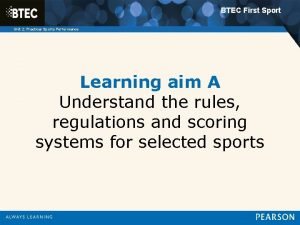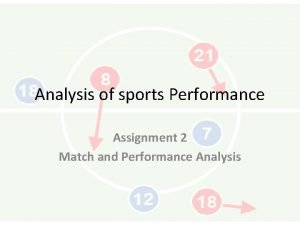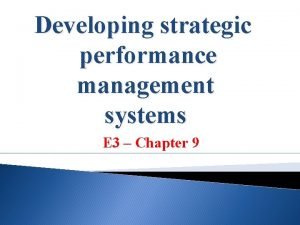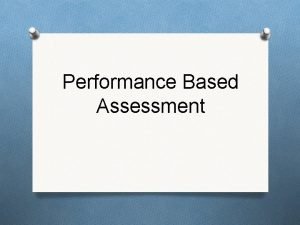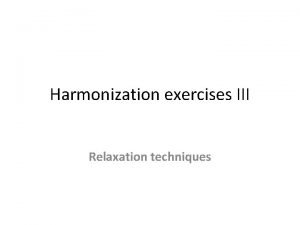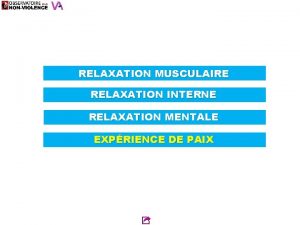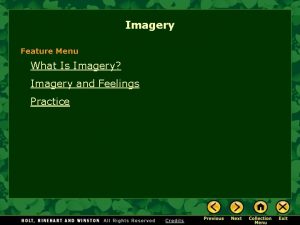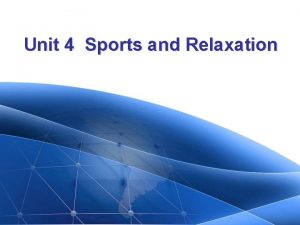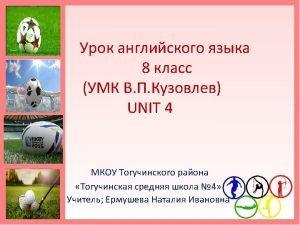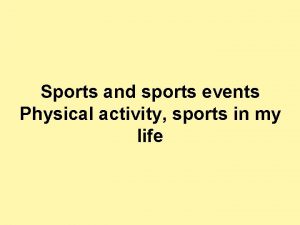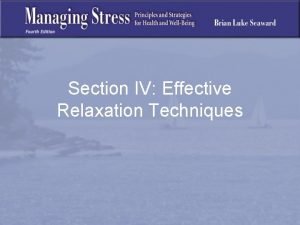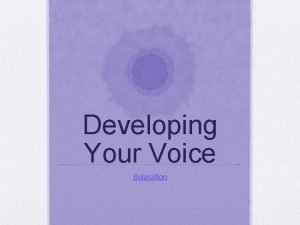SPORTS PERFORMANCE Relaxation Imagery Relaxation is important for



































- Slides: 35

SPORTS PERFORMANCE Relaxation & Imagery

Relaxation is important for you to perform to your potential. If you are too nervous your performance may be affected. A certain amount of nervous energy is good, however you need to find your personal limits.

Relaxation: The release of muscle tension or stress. Relax the body Relax the mind Athletes who have better control over their behavior, actions, and mental states will have an advantage over those athletes who do not.

Relaxation The mind and body work together: whatever goes on in our minds will affect our bodies and vice versa.

Relaxation Three Effects of Relaxation: 1. 2. 3. Reduces muscle tension (perform to best ability). Changes the focus of attention (focus only on important information). Reduces anxiety.

Relaxation Performance Anxiety: A pleasant or unpleasant feeling that can help or impair your performance.

Relaxation Two types of Anxiety: Somatic: physical response – increased heart rate, tense muscles, butterflies. Cognitive: mental response – worry, selfdoubt, loss of confidence/concentration.

Relaxation General sources of stress during competition: § § § Significant others (coaches, teammates, parents, spectators, etc. ). Competitive anxiety and self-doubt (game importance, outcome). Not performing well (making mistakes).

Relaxation As an athlete, it is important that you know what triggers your anxiety. It is also important to know how to either relax or energize yourself in order to stay within your optimal performance zone.

Relaxation When to Relax? § § § Before warm-up. When learning a new skill. Cool down period. Before a competition or game. Before visualization practice. Any time.

Relaxation How to Relax? Breathing Exercises: Take control of your tensions by taking control of your breathing. Breathe out (exhale) = relaxation Breathe in (inhale) = energizing

Relaxation Diaphragmatic Breathing: Correct breathing Belly Breathing: Deep slow breathing coming from the diaphragm. Inhale: belly moves outward Exhale: belly moves in inward

Relaxation Deep Breathing: Breathe in deep, then slowly and completely empty your lungs. More self aware, more relaxed. Rhythmic Breathing: creates a sense of balance. Breathe in count of 4, hold 4, exhale count of 4.

Relaxation Progressive Relaxation: Involves tensing and relaxing specific muscles. The tension-relaxation cycles develop an athlete’s awareness of the difference between tension and lack of tension.

Imagery is a form of simulation. It is similar to a real sensory experience, but the entire experience occurs in the mind. You use imagery to recreate an experience. A mental blueprint for a certain skill.

Imagery should involve as many senses as possible. Visual § Auditory § Touch § Smell § Kinesthetic §

Imagery Example: A Baseball Batter § § § Olfactory (smell) – you smell the freshly mowed grass. Tactile – you feel the bat in your hands and sun beating down on you. Visual – you see the ball as the pitcher releases it and it comes toward the plate. Kinesthetic – you know where your bat is and feel yourself transfer your weight at the proper time to maximize power. Auditory – you hear the crack when the bat hits the ball.

Imagery Once you get good at visualizing all your senses try and attach your emotions to the scene as well. For example anger, joy, pain or anxiety. Recreating emotions through imagery can help control these states.

Imagery Athletes can employ imagery in many ways to improve both physical and psychological skills: § § § § Improve Concentration Build Confidence Control Emotional Responses Acquire and Practice Sport Skills Acquire and Practice Strategy Cope with Pain and Injury Solve Problems

Imagery Improving Concentration: By visualizing what you want to do and how you want to react in certain situations, you can prevent your mind from wandering. You can imagine yourself in a situation where you often lose your concentration and then imaging yourself remaining composed and focused on the next play or step.

Imagery Building Confidence: Seeing yourself perform well in your mind makes you feel you can perform under adverse circumstances.

Imagery Control Emotional Responses Visualizing situations that have caused problems in the past, such as choking under pressure, and then picturing yourself dealing with these events in a positive way, such as taking a deep breath and focusing on your breathing as you concentrate on the task at hand.

Imagery Acquire and Practice Sport Skills You can practice skills to fine-tune them or you can pinpoint weaknesses and visualize correcting them.

Imagery Acquire and Practice Strategy Imagery can be used to practice and learn new strategies or review alternative strategies for either team or individual sports.

Imagery Cope with Pain and Injury Imagery can help speed up recovery of an injured area and keep skills from deteriorating all the while. Imagine doing practice drills and will facilitate recovery.

Imagery Solve Problems If an individual is not performing up to past or expected levels, the player can use imagery to critically examine all aspects of the performance to find the potentially confounding factor.

Imagery Types of Imagery: 1. 2. Internal Imagery: Imagining the execution of a skill from your own vantage point (as if you had a camera on your head). External Imagery: Viewing yourself from the perspective of an external observer (watching yourself on a videotape).

Imagery Keys to Effective Imagery: a. Vividness b. Controllability

Imagery Vividness Good imagers use all of their senses to make their images as vivid and detailed as possible. The closer the images are to the real thing, the better they transfer to the actual performance.

Imagery Vividness Exercises: 1. Imagining home. Imagine that you are home in your living room. Look around and take in all the details. What do you see? Notice the shape and texture of the furniture. What sounds do you hear? What is the temperature like? Is there any movement in the air? What do you smell? Use all your senses and take it all in.

Imagery Vividness Exercises: 2. Imagining a positive performance of a skill. Select a particular skill in your sport and visualize yourself performing it perfectly. Perform the skill over and over in your mind, and imagine every feeling and movement in your muscles. 3. Imagining a positive performance. Recall as vividly as possible a time when you performed very well. If you can recall a finest hour in recent memory, use that. Your visualization will cover three specific areas of recall: visual, auditory, and kinesthetic.

Imagery Controllability Learning to manipulate your images so they do what you want them to do. Controlling your image helps you picture what you want to accomplish instead of seeing yourself making errors. The key to control is practice.

Imagery Controllabililty Exercises: 1. Controlling performance. Imagine working on a specific skill that has given you trouble in the past. Take careful notice of what you were doing wrong. Now imagine yourself performing that skill perfectly while seeing and feeling your movements. Now think about a competitive situation in which you have had trouble in the past. Take careful notice of what you were doing wrong. Now imagine yourself performing that skill perfectly while seeing and feeling your movements.

Imagery 2. Controlling performance against a tough opponent. Picture yourself playing a tough opponent who has given you trouble in the past. Try to execute a planned strategy against this person just as you would for a competition. Imagine situations in which you are getting the best of your opponent. Whatever your sport, make sure you control all aspects of your movements as well as the decisions you make.

Imagery 3. Controlling your emotions. Picture yourself in a situation where you tense up, become angry, lose concentration, or lose confidence. Recreate the situation, especially the feelings that accompany it. Feel the anxiety, then manage your anxiety, let the tension drain from your body and instead focus on what you need to do to execute your skills. Try to control what you see, hear, and feel in your imagery.
 Sports indoor and outdoor
Sports indoor and outdoor From most important to least important in writing
From most important to least important in writing From most important to least important in writing
From most important to least important in writing Least important to most important
Least important to most important Psychological factors affecting sports performance
Psychological factors affecting sports performance Optimum sports nutrition
Optimum sports nutrition Sports and entertainment marketing team decision making
Sports and entertainment marketing team decision making Hollander 1967 model of personality
Hollander 1967 model of personality Physical factors affecting sports performance
Physical factors affecting sports performance Btec sport practical
Btec sport practical Analysis of sports performance assignment 1
Analysis of sports performance assignment 1 Performance sports inc
Performance sports inc Performance management activities
Performance management activities Why is performance management important?
Why is performance management important? Explain performance counselling
Explain performance counselling What is performance-based assessment
What is performance-based assessment Fspos
Fspos Typiska drag för en novell
Typiska drag för en novell Tack för att ni lyssnade bild
Tack för att ni lyssnade bild Ekologiskt fotavtryck
Ekologiskt fotavtryck Varför kallas perioden 1918-1939 för mellankrigstiden?
Varför kallas perioden 1918-1939 för mellankrigstiden? En lathund för arbete med kontinuitetshantering
En lathund för arbete med kontinuitetshantering Särskild löneskatt för pensionskostnader
Särskild löneskatt för pensionskostnader Personlig tidbok
Personlig tidbok A gastrica
A gastrica Densitet vatten
Densitet vatten Datorkunskap för nybörjare
Datorkunskap för nybörjare Boverket ka
Boverket ka Debattartikel mall
Debattartikel mall För och nackdelar med firo
För och nackdelar med firo Nyckelkompetenser för livslångt lärande
Nyckelkompetenser för livslångt lärande Påbyggnader för flakfordon
Påbyggnader för flakfordon Formel för lufttryck
Formel för lufttryck Svenskt ramverk för digital samverkan
Svenskt ramverk för digital samverkan Lyckans minut erik lindorm analys
Lyckans minut erik lindorm analys Presentera för publik crossboss
Presentera för publik crossboss









